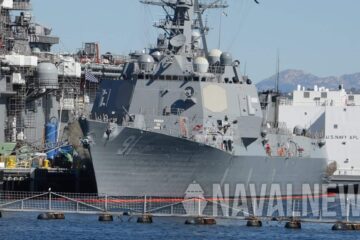The U.S. Navy ships mentioned by the three authors in the “Unclassified, Approved for Public Release” report cover the San Antonio-class Landing Platform Dock (LPD) amphibious assault ship, the Littoral Combat Ship (LCS), and the Spearhead-class Expeditionary Fast Transport (EPF), none of which possess and are configured to carry and launch hypersonic missiles as these three ship types lack the vertical launch systems for the CPS hypersonic missile.
Therefore, the “Bringing Hypersonic Missile Capability to the Fleet” Engineering Report explored the ways to increase the flexibility and capability of U.S. Navy’s ships to launch hypersonic missiles from mobile vehicles being developed by the U.S. Army since the only existing ships planned for the CPS hypersonic missile are the three Zumwalt-class stealth destroyers.
The LCS and LPD will use the U.S. Army’s M870A3 trailer (towed by the M983A4 tractor) to fire the LRHW whereas the EPF will use a stern crane to hoist, suspend, and fire the LRHW missile canister. The reason for this is that the LPD has a Mission Bay and lift that can get the M870 trailer and 6×6 FMTV fire control truck to the helicopter landing deck whereas the LCS and EPF lack such a vehicle lift (either none or too small) to move the vehicles to its Flight Deck. While nascent and speculative, the Engineering Report (which can be accessed at this link) does analyze the possibilities of transporting and launching CPS or LRHW hypersonic missiles from these three ships, including the time involved for setup and breakdown, and the at-sea storage possibilities aboard these vessels.
The Engineering Study Report predicts that if a single M870A3 trailer is used as a launching platform, and by measuring the cargo storage space aboard these three ships, upwards of 10 to 20 LRHW canisters can be stored on a LPD, around 30 hypersonic canisters on a EPF (the EPF can store more than 30 LRHW missiles, but missile weight and cost make storing more than 30 LRHW missile canisters unrealistic), and the LCS can store four LRHW canisters on two M870 trailers in the helicopter hangar since the cargo lift cannot accommodate a 40-foot trailer.

Computer simulations predicted the times estimated to move the M870 trailer, the loading of LRHW canisters onto the M870, launch and preparation setup, missile firing, breakdown and storage of the M870, and spent missile canisters as about 55 minutes for the LPD concept, 50 minutes for the EPF concept, and 22 minutes for the LCS concept. These factors take into account the time it takes to get the trailer to the helicopter flight deck via cargo lift from the interior decks of the ship and how easy it is to maneuver and drive the M870 to and from the launch position. The LPD and EPF can still retain their helicopter landing status on the Flight Deck, but the LCS cannot since the LCS’s interior Mission Bay has no way of getting the M870 trailer to the helicopter flight deck (the lift elevator is too small), hence the trailer can sit inside the helicopter hangar until launch rollout.

Naval News Comments
This Naval Postgraduate School’s Engineering Report seems feasible if the battlespace is secure enough to allow the setup, firing, and breakdown of the LRHW canisters for launch, and according to the Report, that takes close to 22 minutes (LCS) to 55 minutes (LPD and EPF) from setup to breakdown and storage depending on the vessel selected. The LCS can send four LRHW missile rounds to target in 22 minutes (M870 trailer rolled out of the helicopter hangar) whereas the LPD and EPF can store three to seven times more LRHW missiles than the LCS but requires about an hour to setup and breakdown due to retrieving and then storing the M870 trailer back in the interior of the ship. Therefore, the U.S. Navy’s quest to retrofit CPS missile tubes to the three Zumwalt-class stealth destroyers and the four Ohio-class nuclear-powered cruise missile submarines (SSGNs) is logical, or in the future, purpose-build a new ship class specifically designed to carry hypersonic missiles and their vertical launch tubes integrated into the ship’s hull.
The Opinion-Editorial on the Large Unmanned Surface Vessel (LUSV) as an open cargo deck platform, with the LUSV anywhere from 200 to 300 feet long, would also be an ideal place to fire the LRHW from the M870A3 trailer.
Hypothetically, a few M870A3 trailers and the FMTV 6×6 fire control trucks can be placed on the LUSV, or a mix-and-match of Tomahawk cruise missiles in transportable Mark 41 Vertical Launch System (VLS) shipping containers can give the U.S. Navy two missile speed options, hypersonic and subsonic, for Long-Range Precision Fires (LRPF) for deep land attack capabilities.
Another option would be to use the Defense Advanced Research Project Agency’s (DARPA) developing OpFires hypersonic missiles placed on an U.S. Army’s Palletized Load System (PLS) or an USMC’s Logistic Vehicle Replacement System (LVSR) 10×10 wheeled truck. The OpFires medium-range hypersonic missile assembly is more mobile and maneuverable than using a M870A3 trailer, and thus the setup, firing, breakdown, and storage times can be significantly reduced by using a 10×10 truck. The disadvantage would be that the LRHW has a range of 1,725 miles (2,776 kilometers) whereas the OpFires missile has a range of 1,000 miles (1,609 kilometers). As of Winter 2021, the U.S. Army and the USMC have not confirmed their commitment to fielding DARPA’s OpFires.







